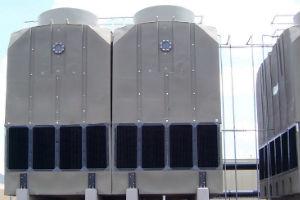 The quiet operation of cooling towers eliminates noise and vibration problems that can be annoying in different installations or spaces.
The quiet operation of cooling towers eliminates noise and vibration problems that can be annoying in different installations or spaces.
by Delta Cooling
Imagine attending a symphonic concert and right in the middle of a violin solo you hear a hum penetrating the ceiling, above the orchestra, and spoiling the meticulous acoustic design of the concert hall.
Or maybe you're performing an operation in a surgery room or you're giving a business presentation in the conference room of an office building and the same hum produced by the cooling tower of the facility's HVAC system, seeps into the environment, leaving attendees a little distracted and upset.
That hum is due to the noise produced by the flow of air generated by the turbulence in the fans of the cooling tower and the water that flows through the cooling tower to the collection bucket. It is the nightmare of residents and operators of office buildings, residences and institutions. Finding a solution to this problem can prove difficult and costly, unless more advanced cooling tower technology is implemented.
In the case of the Woodruff Arts Center Symphony Hall, home of the Atlanta Symphony Orchestra, the Alliance Theatre and the High Museum of Art, the noise came from the conventional cooling towers located on the roof, just above the concert hall.
Steve Trott, engineering director of the arts center complex, says the noise was as if a jet plane passed over the Memorial Arts Building, on whose top floor the Atlanta Symphony Orchestra performs.
About a year ago the noise problem was eliminated and other problems were solved by installing new cooling towers on the roof of the Memorial Arts.
"Our old metal cooling towers were already at the end of their useful life, so we knew we had to replace them soon. We think about acquiring conventional metal towers, made of stainless steel, we are looking for cross-flow and counterflow designs. We then looked at high-density polyethylene (HDPE) cooling towers, which were recommended to us by the Atlanta office of DLB Associates Consulting Engineers. We found that these cooling towers were very quiet, and that they would provide the necessary sound insulation, without having to purchase a special package of silent towers, which would greatly increase costs," explains Trott.
The HDPE design discovered by Trott's team was developed by Delta Cooling Towers primarily to solve the corrosion problems that have plagued metal towers, due to problems such as soft water and environmental factors such as salty air or caustic industrial gases.
Although for years the long service life of these HDPE towers has been a determining factor in purchasing decisions, more recently, quieter operation has acquired great relevance in numerous applications.
Get rid of extra decibels
In recent years, the "noise pollution" produced by commercial HVAC equipment has become an increasingly unwanted problem for communities.
Martin M. Previtera, regional manager of Delta Cooling Towers, says the continued development of inland cities and the increased proximity of commercial and industrial buildings to residential neighborhoods have caused greater concern among building owners and municipal governments.
For example, the Franklin Institute building in Philadelphia recently replaced its cooling towers, and by city command had to restrict sound output to less than 50 decibels, a noise level lower than that of a traditional cooling tower.
"They decided on HDPE cooling towers because of different factors," explains Previtera. "They got a better price and at the same time met the level of less than 50 dBA set. This is a four-cell cooling tower model, the same type of tower installed at Woodruff Arts Center, Atlanta."
To appreciate the difference between the decibel levels, it is enough to look at the description of the Department of Environmental and Civil Engineering at Temple University. The institution considers very important the difference of only 10 dBA (expressed in A-weighted decibles, the relative level of intensity of sounds in the air, as perceived by the human ear), since 70 dBA is the equivalent of the noise produced by a vacuum cleaner and 50 dBA is equivalent to the noise level in a silent suburban house.
"In many cities, companies are occupying residential areas, and some of them require new office buildings to incorporate residential spaces on top of buildings. The occupants of those expensive spaces definitely don't want to hear the noise of the cooling towers," trott says.
Additional Benefits
The Woodruff Arts Center selected for the symphony hall building two sets of the 500-ton model of the TM series with double cell.
Trott says these HDPE towers are providing significant additional benefits. "Another reason we chose these cooling towers was that they are available with direct-drive engines," he explains. That means there's no gearbox or belt, which improves operational reliability and reduces maintenance requirements. At the same time, it allows significant energy savings."
Trott adds that its new cooling towers feature variable speed ventilation units, which allow for very smooth operation and a very consistent water temperature. During the first summer of operation, most of the time the fans were running at 50% or less of the speed, which is more economical.
Trott further notes that the appearance of Delta's cooling towers is attractive, compared to traditional ones. "Ours are a nice tan color that harmonizes with the ceiling; so they do not attract the eye and you do not notice that there is a machine on the ceiling. We believe that the aesthetic features of the cooling tower design are useful in a high-visibility location. Because all of our neighbors are in taller buildings that face our roofs, it's good that they're less visible than traditional towers."













